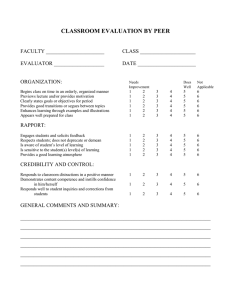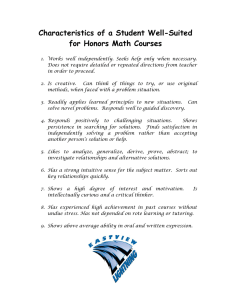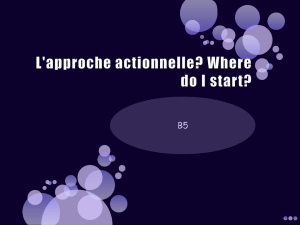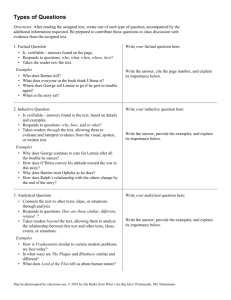German 3 CBE Updated: April 2016 Textbook Titles:
advertisement
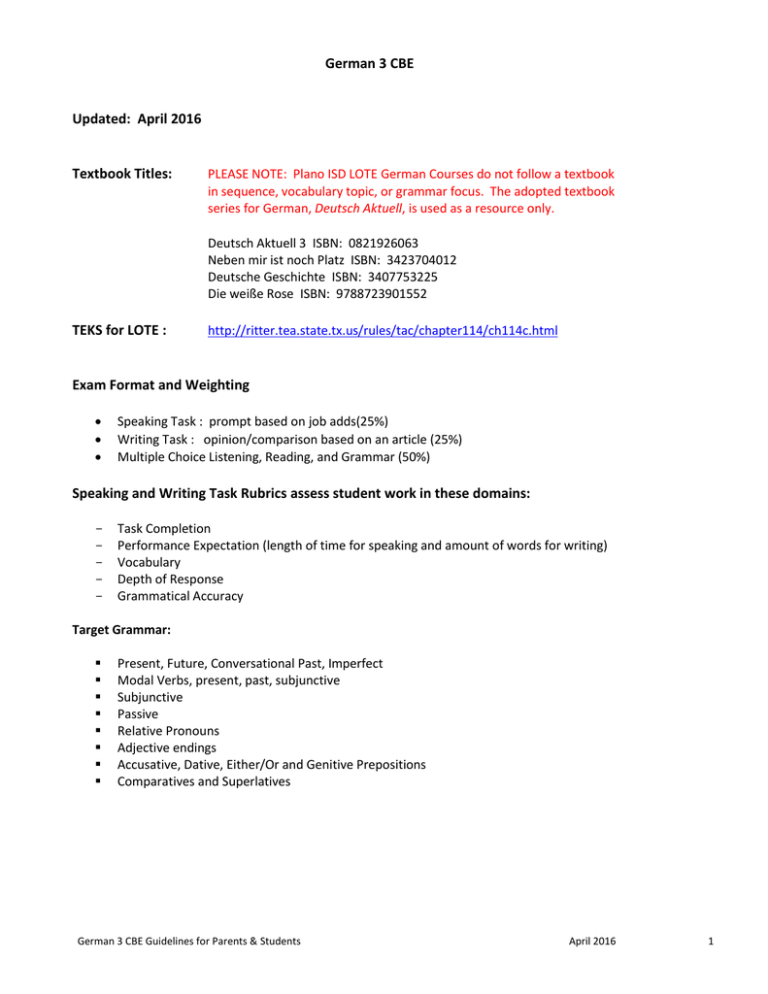
German 3 CBE Updated: April 2016 Textbook Titles: PLEASE NOTE: Plano ISD LOTE German Courses do not follow a textbook in sequence, vocabulary topic, or grammar focus. The adopted textbook series for German, Deutsch Aktuell, is used as a resource only. Deutsch Aktuell 3 ISBN: 0821926063 Neben mir ist noch Platz ISBN: 3423704012 Deutsche Geschichte ISBN: 3407753225 Die weiße Rose ISBN: 9788723901552 TEKS for LOTE : http://ritter.tea.state.tx.us/rules/tac/chapter114/ch114c.html Exam Format and Weighting Speaking Task : prompt based on job adds(25%) Writing Task : opinion/comparison based on an article (25%) Multiple Choice Listening, Reading, and Grammar (50%) Speaking and Writing Task Rubrics assess student work in these domains: - Task Completion Performance Expectation (length of time for speaking and amount of words for writing) Vocabulary Depth of Response Grammatical Accuracy Target Grammar: Present, Future, Conversational Past, Imperfect Modal Verbs, present, past, subjunctive Subjunctive Passive Relative Pronouns Adjective endings Accusative, Dative, Either/Or and Genitive Prepositions Comparatives and Superlatives German 3 CBE Guidelines for Parents & Students April 2016 1 Sample writing rubric Task Completion Performance Expectation Vocabulary Depth of Response Accuracy 6 4 Fully addresses all aspects of the task as defined by the bullets Responds with 150 words or more Responds with interesting & appropriate vocabulary words with few repeated words Partially addresses all aspects of the task Minimally addresses all aspects of the task Does not address all aspects Responds with 149 - 90 words Responds with appropriate but basic vocabulary with some repeated words or redundant sentences Responds with details and limited elaboration of the details; states and supports opinion Responds with connected sentences with some command of tense & mood; grammar sufficiently accurate Responds with 89 - 60 words Responds with 60 words or less Responds with insufficient vocabulary; majority repeated and repetitious Responds with details and elaboration of some details; states and fully supports opinion Responds with connected sentences with good command of tense & mood; generally accurate grammar 2 Responds with limited vocabulary with noticeable repeated words and redundant sentences Responds with details but little elaboration of the details; states opinion Responds with connected sentences with minimal command of tense & mood; grammatical accuracy limited 0 Responds with minimal to no details and no elaboration of the details; may/may not state opinion Responds in sentences with minimal or no awareness of tense, mood or grammatical accuracy Sample speaking rubric 6 Task Completion Performance Expectation Vocabulary Depth of Response Accuracy Fully responds to the prompt; addresses at least 3 personal aspects and gives a convincing argument for an interview. Speaks for 180 seconds or more with no distracting gaps Responds with interesting & appropriate vocabulary words with few repeated words Responds with details and elaboration of some details; states and fully supports personal aspects Responds with connected sentences with good command of tense & mood; generally accurate grammar 2 0 Adequately responds to the prompt; addresses at least 2 personal aspects and gives a rationale for an interview 4 minimally responds to the prompt; addresses at least 2 personal aspects and requests an interview Does not address at least 2 aspects; skeletally responds to the prompt and asks for an interview Speaks for 179 – 110 seconds Speaks for 109 – 60 seconds Responds with appropriate but basic vocabulary with some repeated words or redundant sentences Responds with details and limited elaboration of the details; states and supports personal aspects Responds with connected sentences with some command of tense & mood; grammar sufficiently accurate Responds with limited vocabulary with noticeable repeated words and redundant sentences Responds with details but little elaboration of the details; states personal aspects Responds with connected sentences with minimal command of tense & mood; grammatical accuracy limited Speaks for less than 60 seconds Responds with insufficient vocabulary; majority repeated and repetitious German 3 CBE Guidelines for Parents & Students Responds with minimal to no details and no elaboration of the details; may/may not address aspects Responds in sentences with minimal or no awareness of tense, mood or grammatical accuracy April 2016 2 German 3 OVERVIEW Part 1 Concepts to Know and Understand: Creating appropriate responses to content-based situation Using context demonstrating understanding of written & oral texts Acquiring accuracy in structures to reduce the chance of miscommunication & to increase sophistication in communication Telling personal stories & stories about others using appropriate time frames & mood Recognizing differences in products, practices, & perspectives among cultures. Ausländer Küss mich Frosch Focus Questions Focus Questions How are immigrants treated in Germany? What are the challenges that they face? What did the basic elements of a classical German fairy tale originate? What truths and life lessons are illustrated in German fairy tales? Learning Targets 1. I can describe typical reactions immigrants will have in specific situations. 2. I can compare attitudes towards immigrants in the German culture with attitudes towards immigrants in other cultures. 3. I can connect with personal stories told by immigrants in Germany. 4. I can ask for advice, recommendations, and suggestions and give the same to others. 5. I can state and support my opinions and preferences and ask others about their opinions and preferences. 6. I can describe people, places, objects and events. 7. I can relate an experience or explain a situation (informational, personal, or historical) in appropriate time frame and mood using connected sentences. Topics: Prejudices and stereotypes Challenges faced by immigrants Personal characteristics World Geography Learning Targets 1. I can understand the main idea, details, and themes of authentic German fairy tales. 2. I can explain the significance and cultural perspectives of the recurring themes and elements of fairy tales. 3. I can compare and contrast fairy tales in the German culture with fairy tales or folk tales in other cultures. 4. I can state and support my opinions and preferences and ask others about their opinions and preferences. 5. I can describe people, places, objects, and events 6. I can relate an experience or explain a situation (informational, personal, or historical) in appropriate time frame and mood using connected sentences. Topics: Elements of Fiction Components of fairy tales and fables Characters and Stereotypical Characters in fairy tales Morals and Life lessons German 3 CBE Guidelines for Parents & Students April 2016 3 German 3 OVERVIEW Part 2 Deutsche Geschichte Der Widerstand Focus Questions Focus Questions How do historical events shape societies and cultures? What is society’s responsibility in preserving human rights? What is an individual’s responsibility in preserving human rights? Learning Targets 1. I can describe the causes of significant historical events in Germany. 2. I can connect political movements with historical events. 3. I can connect historical events and their consequences. 1. 4. I can ask for advice, recommendations, and suggestions and give the same to others. 5. I can state and support my opinions and preferences and ask others about their opinions and preferences. 6. I can describe people, places, objects and events. 7. I can relate an experience or explain a situation (informational, personal, or historical) in appropriate time frame and mood using connected sentences. Topics: Events significant in the history of Germany Important or influential people involved in important historical events Causes and lasting effects of significant historical events Influential movements and the people behind them Learning Targets I can describe the German Resistance Movement within its historical and cultural perspective. 2. I can explain generally accepted human rights 3. I can describe generally accepted responsibilities of those living in a cultural community. 4. I can compare acceptable resistance with unacceptable resistance. 5. I can state and support my opinions and preferences and ask others about their opinions and preferences. 6. I can describe people, places, objects, and events 7. I can relate an experience or explain a situation (informational, personal, or historical) in appropriate time frame and mood using connected sentences. Topics: Causes and effects of World War 2 Characteristics of resistance movements during wartime Human Rights Responsibilities within a cultural community German 3 CBE Guidelines for Parents & Students April 2016 4
